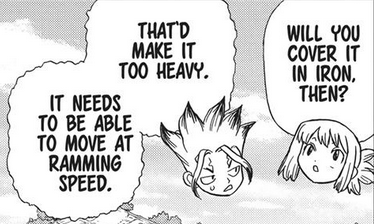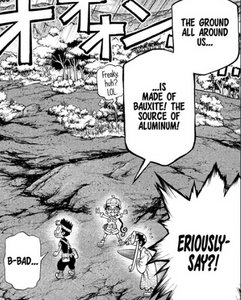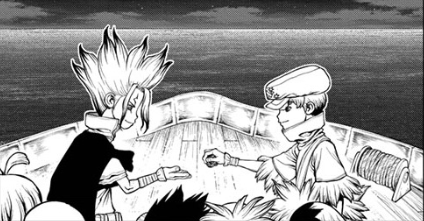Logbook Entry 209: The Rocket's Hard Truth
- aboardtheperseus

- Sep 8, 2021
- 6 min read
In this chapter, the focus has switched back to Senku’s group. Xeno’s group in South America is still working on the rocket engine, but there's a new addition to the line of work. Yuzuriha, as well as the Corn City residents oversee the computer construction.
One thing that must be noted: we still haven't gotten a dialogue box for ‘Math City’ formed. Also, we have no information for where the rocket will be launched from. So maybe, the rocket will be launched from India? Would certainly give the ‘Math City’ label a greater meaning. The new residents in Spain digging for Fluorite weren't declared as "Fluorite City" either, but the city might just be named Barcelona again.

Onward to the next city on the map, Aluminum City. A bit of a surprise, considering Rubber City is closer (Indonesia/Thailand), but we learn the location of Aluminum city. A country that most people had already guessed, Australia. Australia is the world’s largest producer of bauxite. Bauxite is a naturally occurring ore in the ground, composed of one or more aluminum hydroxide minerals, plus other minerals in trace amounts. It is used to produce alumina, which is then used to produce aluminum.
Bauxite (rocks), Alumina (powder), Aluminum
Even though Bauxite is the most abundant in Australia, China is the world’s largest producer of Aluminum.

What exactly do they need aluminum for? To construct the main body of the rocket, where the astronauts will be housed. Senku explains that this is because aluminum is light compared to other metals. It has a specific density of 2.7 grams per cubic metre (Iron has a density of 7.847 gram per cubic metre. Stainless steel has a density of approximately 7.5-8 grams per cubic metre. Dependent on the alloy present in it).
Kohaku guessed that they would use iron for the rocket body, which is a similar guess to what she had in Stone Wars. Back then she thought they would use iron for the steam gorilla.
Aluminum is the metal of choice for a vastly wide variety of applications from soda cans to airplanes to trailers and even camping. It's very light yet still strong, doesn't rust, is a good conductor of heat and electricity, but it's a bit more expensive so it's only used when it's really necessary.
Once they arrive in Australia, Chrome challenges Chelsea to an excavation match. He had set up a rivalry with her before in the manga, but this is the first time we see him acting on it.
To Chrome’s disappointment however, it ends up not being much of a competition. The entire ground below them is covered in bauxite. A bit like the ground on Araxa. Back in Araxa, they had to filter the ground for precious stones. The basic principle is the same behind both though, a natural abundance of minerals below them.
Another interesting fact, the bauxite in the soil has a direct effect on agricultural practices in the land. It does not directly affect fertility, like copper ions do (think of the bronze Buddha statue that Senku, Yuzuriha and Taiju ran into in Japan). It's only present in such high quantities that the ratio between fertile soil to bauxite and other stuff makes the ground unusable for agriculture. Only 6% of the soil is good for farming.
Even the act of mining the bauxite influences soil fertility. This of course means that Senku’s group cannot opt for agriculture, like they did in Spain and USA. There's the option for hunting as well, if Kohaku is able to do it.
With a food shortage however, this means one thing: Food must be imported. Yo and Ukyo show up on a ship -- the same one that Taiju and Ukyo's group took from South America to Corn City. As a former sonar person, Ukyo is essential in any form of naval transport. Yo is there with him as security.
In America, Ukyo was the one who handed over the device to Xeno’s group. This time, along with the corn, he brings the Treasure Island Medusa to Senku’s crew. Meaning we finally learn the fate of the device.
Senku tests out the Medusa, using one of Kaseki’s batteries. The device works perfectly. They then take a Medusa from the large pile in South America and insert one of Joel’s batteries in it. Joel was the first one to make the batteries work. His batteries are obviously flawless. To everyone’s surprise however, the Medusa does not activate this time.
This gives us an answer from the South American arc, something we were curious of this whole time as readers. We do not know how the diamond batteries were made to work, but we know that the Medusas in the pile were defective. If Joel was in Kaseki’s place in South America, he also would not have gotten the Medusas to activate. The weird bit is that the South America Medusas themselves have no visible defects on them, only the blackened batteries. The Treasure Island one has cracks from when Stanley shot it, but it still works well enough. Could this mean that the Medusas themselves have a lifespan? Past a certain timespan, they stop being functional. Or maybe the ones in the Amazon work on something else other than voice commands, or some other difference in design.
With the working Medusa at hand, Senku reveals the last bit of his plan. The trio who goes to the moon won't have a way back to earth. There's simply no time to create a return vessel. So once Why Man is defeated, they'll use the functional Medusa to petrify themselves. Then wait for those on earth to come save them. Senku says it could be centuries before that happens. It's difficult to imagine how the story would go if that were the case. They possibly won't see the rest of the cast again?

This chapter dives back into the Medusa shenanigans, which is a key element of this story's giant petrification mystery. We learn a bit more about the Medusa, and how a device can be defective, even with a functional battery in it. It seems we'll eventually learn the details of the differences between the Treasure Island Medusa and the ones in South America.
The moon mission is also becoming a reality, with so many hypothetical images. It portrays Senku, Ryusui, and Tsukasa, but they aren't declaring that those are the three to go. In the dialogue, it still only calls them "the pilot, the warrior, and the scientist".

Senku’s plan makes sense, but I feel like its a bit reckless. He doesn't even know for a fact that the Medusa would work on a surface like the moon. Also, what would happen if an asteroid hit the moon, smashing their statues into rubble? His reasons for rushing also make sense in the light of the second global petrification, but there should be a better way of handling things.
What can we expect for next chapter? It seems obvious there will be some resistance to this, from others in the group. Ryusui just recently reunited with his brother, so Sai being separated from him for a long time would obviously be something he’s opposed to. There’s also Taiju in USA, he wouldnt want to be separated from his childhood/best friend. Chrome is a bit of a sentimental scientist, so he will obviously have something to say about this as well. Remember he thought the immortality aspect of the Medusa was good since it meant Kaseki stays around longer. He went so far as to completely refuse Senku’s plan when Senku told Chrome not to join them at Sulfurina’s lake.
There would be a compromise, but what it will be? A bigger space ship? Carrying revival fluid to the moon?
However, in Dr. Stone it seems that securing the fate of humanity trumps all of these types of interpersonal concerns. So don't be surprised if it's not addressed.
Trivia:
- Australia is the first country in the series where they did not eat a food associated with the country.

- The imagery for Aluminum City is an aero plane. Like Math City, Super Alloy City and Corn City before it. This is because airplanes are made from aluminum. The airframe of a typical modern commercial transport aircraft is 80% aluminum by weight. As mentioned earlier in the review, aluminum is roughly a third the weight of steel, allowing an aircraft to carry more weight and or become more fuel efficient. Furthermore, aluminum's high resistance to corrosion ensures the safety of the aircraft and its passengers.
-The bucket wheel excavator brought up in the chapter is the largest land vehicle known to man. It moves at an average speed of between 5 and 30 meters per minute, depending on the operations. It also weighs 31.3 million pounds, which is a Guinness record as the heaviest vehicle on land.


























Comments